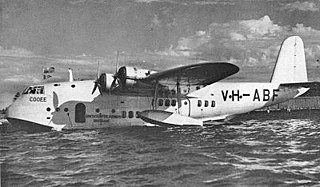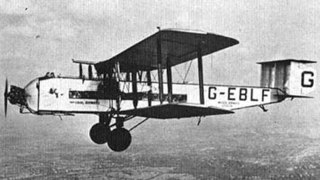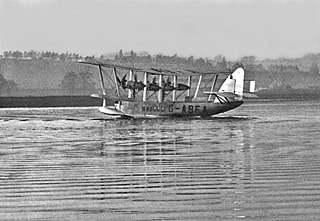Related Research Articles

Imperial Airways was an early British commercial long-range airline, operating from 1924 to 1939 and principally serving the British Empire routes to South Africa, India, Australia and the Far East, including Malaya and Hong Kong. Passengers were typically businessmen or colonial administrators, and most flights carried about 20 passengers or fewer. Accidents were frequent: in the first six years, 32 people died in seven incidents. Imperial Airways never achieved the levels of technological innovation of its competitors and was merged into the British Overseas Airways Corporation (BOAC) in 1939. BOAC in turn merged with the British European Airways (BEA) in 1974 to form British Airways.

A flying boat is a type of seaplane with a hull, allowing it to land on water. It differs from a floatplane in having a fuselage that is purpose-designed for flotation, while floatplanes rely on fuselage-mounted floats for buoyancy.
Short Brothers plc, usually referred to as Shorts or Short, is an aerospace company based in Belfast, Northern Ireland. Shorts was founded in 1908 in London, and was the first company in the world to make production aeroplanes. It was particularly notable for its flying boat designs manufactured into the 1950s.

The Short Empire was a medium-range four-engined monoplane flying boat, designed and developed by Short Brothers during the 1930s to meet the requirements of the growing commercial airline sector, with a particular emphasis upon its usefulness upon the core routes that served the United Kingdom. It was developed and manufactured in parallel with the Short Sunderland maritime patrol bomber, which went on to serve in the Second World War; a further derivative that was later developed was the piggy-back Short Mayo Composite.

This is a list of aviation-related events from 1960.

The de Havilland Express, also known as the de Havilland D.H.86, was a four-engined passenger aircraft manufactured by the de Havilland Aircraft Company between 1934 and 1937.
A transatlantic flight is the flight of an aircraft across the Atlantic Ocean from Europe, Africa, South Asia, or the Middle East to North America, Latin America, or vice versa. Such flights have been made by fixed-wing aircraft, airships, balloons and other aircraft.

The Speedbird is the stylised emblem of a bird in flight designed in 1932 by Theyre Lee-Elliott as the corporate logo for Imperial Airways. It became a design classic and was used by the airline and its successors – British Overseas Airways Corporation (BOAC) and British Airways – for 52 years. The term "Speedbird" is still the call sign for British Airways.
Tasman Empire Airways Limited (1940–1965), better known by its acronym TEAL, is the former name of Air New Zealand.

The Short S.25 Sandringham is a British civilian flying boat designed and originally produced by Short Brothers. They were produced as conversions of the widely used Short Sunderland, a military flying boat that was commonly used as a maritime patrol aircraft.

The Armstrong Whitworth Argosy was a three-engine biplane airliner designed and produced by the British aircraft manufacturer Armstrong Whitworth Aircraft. It was the company's first airliner.

The Short S.26 G-class was a large transport flying boat designed and produced by the British aircraft manufacturer Short Brothers. It was designed to achieve a non-stop transatlantic capability, increasing the viability of long distant services/duties.

Union Airways of New Zealand Limited was New Zealand's first major airline. It was founded in 1935 by local shipping giant Union Company. Its services reached main centres from Auckland to Dunedin and extended to Gisborne and the West Coast of the South Island. Union Airways was instrumental in the establishment of Australian National Airways and TEAL.

The Short L.17 Scylla was a British four-engined 39-seat biplane airliner designed and built by Short Brothers at the request of Imperial Airways to supplement the Handley Page H.P.42 fleet already in service after Handley Page quoted an excessive price for two additional H.P.42s. They were ordered in 1933.

The Short S.17 Kent was a British four-engined 15-seat biplane luxury flying boat airliner, designed and built by Shorts to meet a requirement from Imperial Airways for an aircraft with greater range than the Short Calcutta. The new aircraft was to have sufficient range to fly the stage from Mirabella, Crete, to Alexandria in Egypt without the need for refuelling stops in Italian colonial territory due to a political row which had led the Italian Government to ban British aircraft from its ports.

The Short S.16 Scion and Scion II were 1930s British two-engine, cantilever monoplanes built by Short Brothers and by Pobjoy Airmotors and Aircraft Ltd. in Rochester, Kent between 1933 and 1937. Altogether 22 Scion/Scion II aircraft were built and they provided useful service to operators working from small airstrips/water courses in many parts of the globe, including Europe, the Near and Middle East, Sierra Leone, Papua New Guinea and Australia. Many were impressed into the Royal Air Force during the Second World War, providing pilot ferry services, anti-aircraft co-operation and radar calibration duties. Of the civilian Scions, at least two were still operating in Australia in 1966, one having been re-engined with de Havilland Gipsy Minor engines.

The de Havilland DH.66 Hercules was a British 1920s seven-passenger, trimotor airliner built by de Havilland Aircraft Company. With the Hercules, Imperial Airways took over responsibility for the airmail service from the Royal Air Force, which had been operating the obsolete Airco DH.10 Amiens.

Seaplane Squadron was a flying unit of the Royal Australian Air Force (RAAF) between the wars. It operated Supermarine Southampton flying boats from January 1928, as well as other types. Along with Fighter Squadron, Seaplane Squadron was a component of No. 1 Flying Training School, based at RAAF Point Cook, Victoria. Seaplane Squadron was responsible for coastal reconnaissance, training aircrew to operate seaplanes, and supporting the Royal Australian Navy. It also conducted survey flights over remote parts of Australia and mapped the Darwin–Sydney section of the Empire Air Mail Scheme route. Seaplane Squadron was disbanded in June 1939.
National Air Communications was a British government organisation that directed civilian flying operations from the outbreak of World War II until April 1940.

British Overseas Airways Corporation (BOAC) was the British state-owned airline created in 1939 by the merger of Imperial Airways and British Airways Ltd. It continued operating overseas services throughout World War II. After the passing of the Civil Aviation Act 1946, European and South American services passed to two further state-owned airlines, British European Airways (BEA) and British South American Airways (BSAA). BOAC absorbed BSAA in 1949, but BEA continued to operate British domestic and European routes for the next quarter century. The Civil Aviation Act 1971 merged BOAC and BEA, effective 31 March 1974, forming today's British Airways.
References
- ↑ Davies, R E G (1964). A History of the World's Airlines. Oxford: Oxford University Press.Davies, R E G (1964). A History of the World's Airlines. Oxford: Oxford University Press.
- ↑ Chapman, Richard A (1988). Ethics in the British Civil Service. Routledge. p. 142. ISBN 9780415003346.
- ↑ Lloyd, Geoffrey (15 June 1972). "Memorial Service for Sir Christopher Bullock K.C.B., C.B.E." (PDF).
- 1 2 Ewer, Peter (2009). Wounded Eagle: The Bombing of Darwin and Australia's Air Defence Scandal. Sydney: New Holland.
- 1 2 Barnes, Christopher (1989). Shorts Aircraft Since 1900. London: Putnam.
- ↑ Smith, Richard (1983). "The Intercontinental Airliner and the Essence of Airplane Performance 1929–1939". Technology and Culture. 24 (3): 428–449. doi:10.2307/3104760. JSTOR 3104760. S2CID 111745609.
- 1 2 Ewer, Peter (2007). "A Gentlemen's Club in the Clouds: Re-assessing the Empire Air Mail Scheme 1933–1939". Journal of Transport History. 28 (1). doi:10.7227/TJTH.28.1.6. S2CID 144016759.